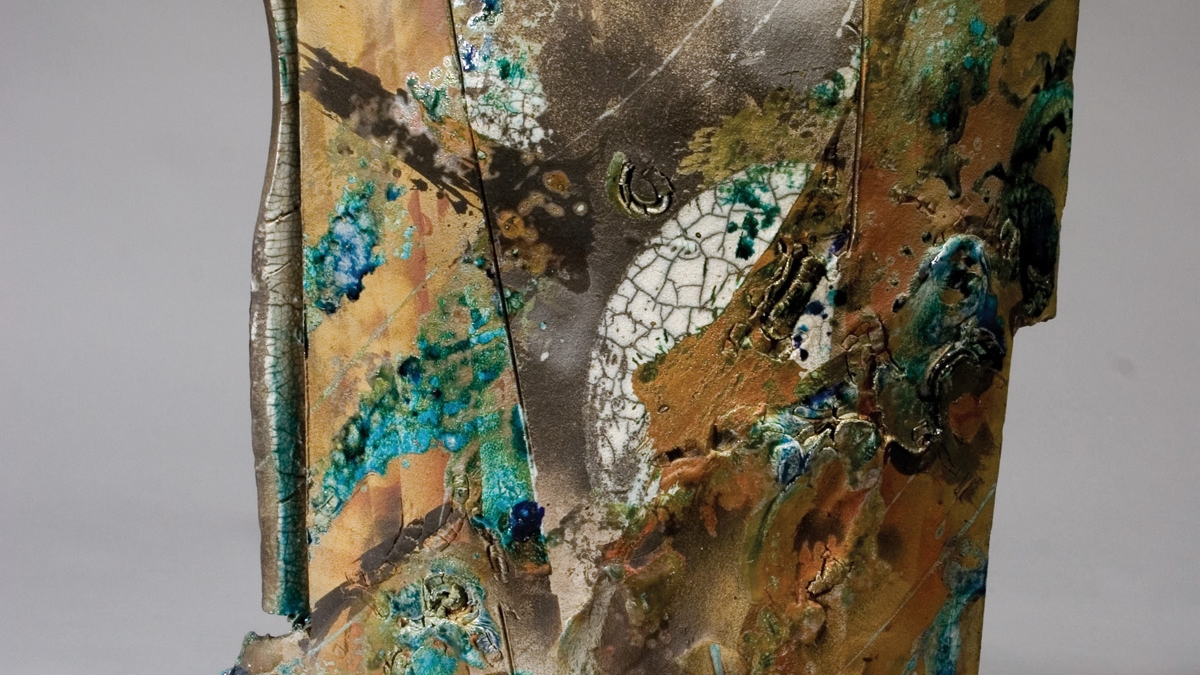Centuries-old Japanese pottery technique shown in Raku: Origins, Impact and Contemporary Expression

Jim Romberg, Canyon Moon, 2005. Raku-fired ceramic, 26” x 15” x 8”.
Photo courtesy of Herberger Institute for Design and the Arts.
TEMPE, Ariz. - The ASU Art Museum Ceramics Research Center presents a global perspective of contemporary ceramic artists using the ancient Japanese Raku firing technique in the exhibition Raku: Origins, Impact and Contemporary Expression, Jan. 13 – April 21, 2007. The opening reception Jan. 19, 6-8 p.m., includes a 7 p.m. gallery talk with exhibition guest curator Jim Romberg of the Eagleheart Center for Art and Inquiry.
The exhibition features 50 contemporary works of decorative vessels and expressive sculpture by Jim Romberg, Rick Hirsch and Paul Soldner (USA); Aline Favre and Fabienne Gioria (Switzerland); Tim Andrews and David Jones (UK); Jean Biagini (France); Ching-Yuan Chang (Taiwan); and Toshio Ohi (Japan).
Raku ware marked an important point in the historical development of Japanese ceramics. With the formal recognition of Raku potters in the late 16th century, the Japanese artist-potter first emerged from the anonymity of the general craftsman. Raku tea bowls were much revered by tea masters for their simple forms and surfaces that emulated nature, such as rock formations, pools of water or grass patterns.
The Raku technique is characterized by low firing temperatures and the removal of works from the kiln while glowing hot, then submerged in either sawdust or straw which combust to achieve unique patterns on the clay?s surface. A number of American ceramists in the 1960s revived and adapted the technique to suit their personal aesthetic, with the use of a reduction chamber at the end of the Raku firing. This technique was introduced by artist Paul Soldner, who continues to conduct workshops at age 85.
"The Ceramics Research Center is pleased to present this stellar international survey of raku ceramics, augmented by the center's holdings of this technique," says Peter Held, ceramics curator for the ASU Art Museum. A workshop for high school art teachers is Jan. 20, 10 a.m. ? 1 p.m., including artist demonstrations and lesson plans, a gallery talk by Jim Romberg and a student art competition sponsored by the Tempe Festival of the Arts, March 30 - April 1, 2007. Space is limited. RSVP to Laura.Stewart@asu.edu, or call 480-965-2873 by Jan. 17, 2007.
Organized by the ASU Art Museum, this exhibition is guest-curated by Jim Romberg and is made possible in part through investments by the Eagleheart Center for Art and Inquiry, Ceramics Leaders of ASU (CLA) and Friends of the ASU Art Museum.
The ASU Art Museum, named "the single most impressive venue for contemporary art in Arizona" by Art in America, is part of the Herberger College of Fine Arts at Arizona State University. Its Ceramics Research Center is located on the northeast corner of Mill Avenue and 10th Street in Tempe. Hours are 10 a.m. - 5 p.m., Wednesday through Saturday. Admission is free. For more information, call 480-965-2787 or visit the museum online at http://asuartmuseum.asu.edu.
Media Contact:
Denise Tanguay
480.965.7144
denise.tanguay@asu.edu